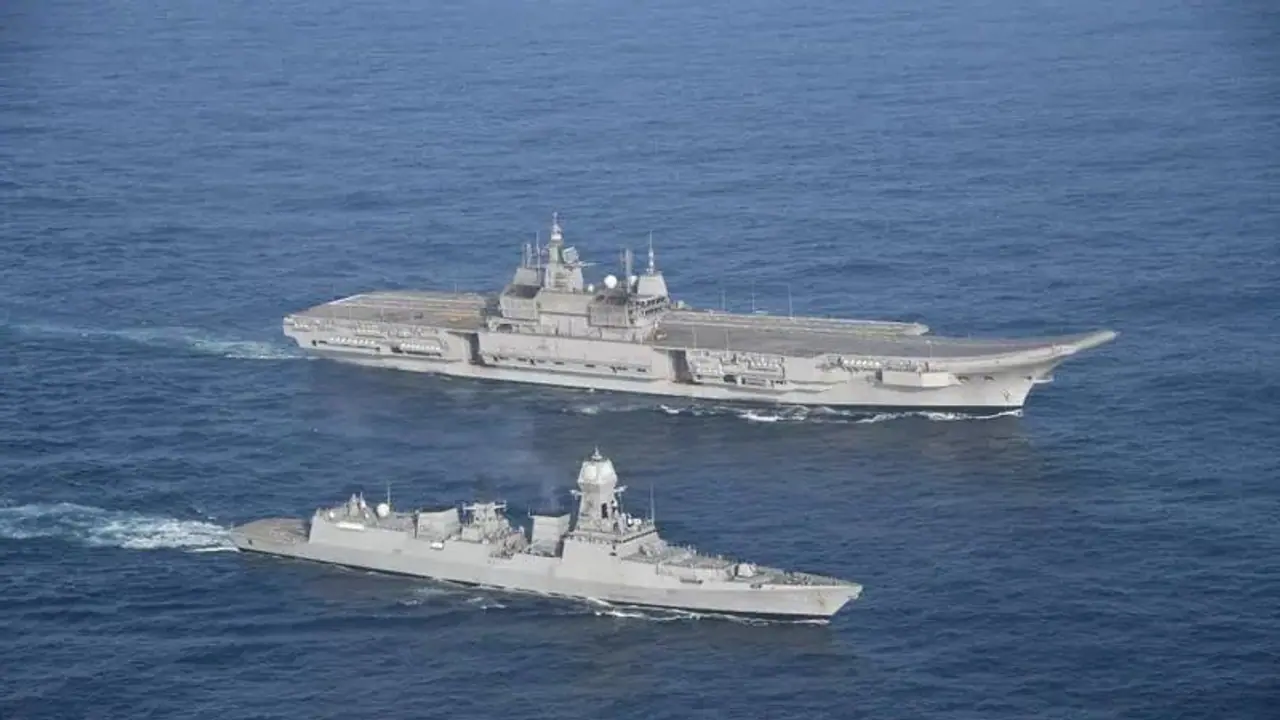India's naval journey, from commissioning INS Nilgiri in 1972 to inducting the indigenous INS Vikrant in 2022, highlights strides in self-reliance, defence innovation, and strategic foresight. With plans for IAC-2 and emerging technologies, India cements its position as a maritime power in the Indo-Pacific.
By Ruchi Singh

The commissioning of INS Nilgiri in 1972, the Indian Navy's first indigenously built warship, marked the dawn of a new era in India's maritime journey. Half a century later, the induction of the 37,500-ton INS Vikrant in 2022 cemented India's position as a maritime power and highlighted its strides in self-reliance and defence innovation. From humble beginnings to a sophisticated naval force, the Indian Navy's evolution offers a compelling narrative of ambition, perseverance, and strategic foresight.
A Humble Beginning: INS Nilgiri
INS Nilgiri, a Leander-class frigate constructed at Mazagon Dock Shipbuilders Limited (MDL) in collaboration with Yarrow Shipbuilders of the United Kingdom, was a symbol of India's emerging technical expertise. The decision to domestically build a modern frigate was audacious at the time, considering the nation's limited industrial base.
The 3,000-ton frigate integrated advanced technology for its era, including Dutch Signal radars and British Vickers guns.
Local industries were roped in to produce components such as valves and pumps, fostering an ecosystem of domestic defence manufacturing. Nilgiri's success bolstered confidence in India's ability to design and build modern warships, paving the way for subsequent projects such as the Shivalik-class frigates.
"INS Nilgiri wasn't just a ship; it was a stepping stone for India's shipbuilding aspirations," reflects Commodore Ranjit Rai (Retd), a former naval officer involved in its commissioning. "It taught us lessons in technology transfer, project management, and naval operations," the veteran added.
The Turning Point: INS Vikramaditya and Modernisation
Fast-forward to the early 2000s, the Navy grappled with ageing assets. The acquisition of the INS Vikramaditya, formerly the Soviet-built Admiral Gorshkov, provided a much-needed capability boost. Modernised extensively at the Sevmash Shipyard in Russia, the 44,500-ton carrier became operational in 2014, serving as a floating airbase for MiG-29K fighters and KA-31 helicopters.
While Vikramaditya's induction enhanced India's maritime reach, its retrofitting highlighted the challenges of relying on foreign-built platforms. The delays and cost overruns reinforced the Navy's resolve to develop indigenous capabilities, culminating in the construction of INS Vikrant, India's first home-built aircraft carrier.
INS Vikrant: A Milestone in Aatmanirbharta
Commissioned in 2022, INS Vikrant is a testament to India's progress in defence manufacturing. Built by Cochin Shipyard Limited (CSL), the 262-meter-long carrier employs a Short Take-Off But Arrested Recovery (STOBAR) configuration, enabling the operation of MiG-29Ks and advanced helicopters.
The ship features cutting-edge systems such as:
● MF-STAR radar, co-developed with Israel, for air and surface tracking.
● Barak-8 missiles for long-range air defence.
● Indigenous steel and equipment supplied by over 100 Indian companies, including Larsen & Toubro and Bharat Electronics Limited.
Notably, 76% of Vikrant's components were sourced domestically, a feat achieved through collaboration with Indian MSMEs. The indigenisation efforts behind Vikrant are a shining example of what India can achieve with focused policies like 'Make in India' and strong industry-government cooperation.
Geopolitical Significance in the Indo-Pacific
As a resident power in the Indian Ocean Region (IOR), India's maritime strategy has evolved to address contemporary geopolitical challenges. The Indo-Pacific, a theatre of growing contestation, underscores the need for strong maritime capabilities.
China's naval expansion, exemplified by its third aircraft carrier Fujian, and its aggressive posture in the IOR, has prompted India to bolster its naval assets. The INS Vikrant and Vikramaditya represent a strategic counterweight, ensuring India's ability to project power and safeguard its maritime interests.
Furthermore, India's carrier program supports its diplomatic outreach. Naval visits and joint exercises have strengthened partnerships with countries like the United States, Japan, and France, aligning with India's vision of a "free, open, and inclusive Indo-Pacific."
The Road Ahead: IAC-2 and Emerging Technologies
Looking forward, the Navy has ambitious plans for a second indigenous carrier, tentatively referred to as IAC-2. Expected to feature a larger displacement and an Electromagnetic Aircraft Launch System (EMALS), IAC-2 would enhance India's power projection capabilities.
Parallelly, the Navy is exploring disruptive technologies, including unmanned underwater vehicles (UUVs), artificial intelligence (AI) for fleet operations, and hypersonic missiles. These advancements, coupled with lessons from INS Vikrant, are expected to shape India's maritime strategy in the future.
The Navy's trajectory is clear—investing in platforms and technologies that ensure dominance in the IOR while preparing for contingencies in the broader Indo-Pacific.
Economic and Industrial Impact
Beyond strategic imperatives, the Navy's modernisation has catalysed economic growth. Projects like Vikrant have stimulated India's shipbuilding industry, creating jobs and fostering innovation. The involvement of over 400 MSMEs in Vikrant's construction has had a cascading effect on ancillary industries, contributing to India's defence export ambitions.
Notably, Larsen & Toubro's shipyard in Kattupalli recently repaired a US Navy ship, highlighting India's emergence as a hub for shipbuilding and maintenance services.
The journey from INS Nilgiri to INS Vikrant epitomises India's maritime evolution—from learning to build modern warships to becoming a self-reliant naval power. As the Navy charts its course toward future capabilities, it carries forward a legacy of resilience, innovation, and strategic vision.
India's growing naval capabilities symbolise national pride and a vital pillar of its global aspirations. Prime Minister Narendra Modi aptly noted, "The Indian Navy's potential must be harnessed for India to rise." Indeed, with projects like INS Vikrant and the vision for IAC-2, India is navigating confidently toward a maritime future that befits its stature on the world stage.
(Ruchi Singh is a seasoned journalist specialising in defence, security, foreign affairs, and aerospace. With a distinguished career at leading news channels such as TV Today Network, India News, News24, and Zee News, she has become a trusted voice in the industry. As a producer and analyst, Ruchi delivers incisive and impactful stories that resonate with both audiences and policymakers. Follow her insights on Twitter: @RuchiSinghNews.)
